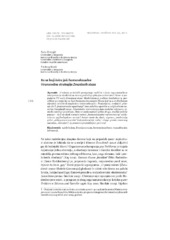Ko se boji kvira još: homoseksualne i transrodne strategije "Zvezdanih staza"
Who is (Still) Afraid of Queer: Homosexual and Transgender Strategies of Star Trek
Апстракт
This text gives a critical account of various, often conflicting interpretations of slash fiction – stories based on characters from popular TV show, The Star Trek, written (and read) by fans. What makes slash fiction, a subgenre of fan fiction, specific is a homoeroticization of characters that in the original narratives are either explicitly or implicitly heterosexual. Whether such “homoerotic pairing” has any foundation in the original Star Trek narrative, remains an open question. Answers to this question vary greatly. An affirmative answer, however, begs a further question: whether these narratives are “homosexual representations” in a strict gay/lesbian sense? The authors propose that slash represents a non-hegemonic narrative which transgresses borders (of the medium, genre, gender, sexuality etc.) set up in the original narrative – queering, reexamining thus both sex and gender.
Кључне речи:
slashfiction / salshfiction / Star Trek / Zvezdane staze / homosexuality / homoseksualnost / transdžender / transgender / kvirovanje / queeringИзвор:
Filozofija i društvo/Philosophy and Society, 2013, 196-211Финансирање / пројекти:
- Истраживање климатских промена и њиховог утицаја на животну средину - праћење утицаја, адаптација и ублажавање (RS-MESTD-Integrated and Interdisciplinary Research (IIR or III)-43007)
- Ретке болести: молекуларна патофизиологија, дијагностички и терапијски модалитети и социјални, етички и правни аспекти (RS-MESTD-Integrated and Interdisciplinary Research (IIR or III)-41004)
Институција/група
IFDTTY - JOUR AU - Drezgić, Rada AU - Krstić, Predrag PY - 2013 UR - http://rifdt.instifdt.bg.ac.rs/123456789/1009 AB - This text gives a critical account of various, often conflicting interpretations of slash fiction – stories based on characters from popular TV show, The Star Trek, written (and read) by fans. What makes slash fiction, a subgenre of fan fiction, specific is a homoeroticization of characters that in the original narratives are either explicitly or implicitly heterosexual. Whether such “homoerotic pairing” has any foundation in the original Star Trek narrative, remains an open question. Answers to this question vary greatly. An affirmative answer, however, begs a further question: whether these narratives are “homosexual representations” in a strict gay/lesbian sense? The authors propose that slash represents a non-hegemonic narrative which transgresses borders (of the medium, genre, gender, sexuality etc.) set up in the original narrative – queering, reexamining thus both sex and gender. T2 - Filozofija i društvo/Philosophy and Society T1 - Ko se boji kvira još: homoseksualne i transrodne strategije "Zvezdanih staza" T1 - Who is (Still) Afraid of Queer: Homosexual and Transgender Strategies of Star Trek SP - 196 EP - 211 DO - 10.2298/FID1303196D ER -
@article{
editor = "Jovanov, Rastko",
author = "Drezgić, Rada and Krstić, Predrag",
year = "2013",
abstract = "This text gives a critical account of various, often conflicting interpretations of slash fiction – stories based on characters from popular TV show, The Star Trek, written (and read) by fans. What makes slash fiction, a subgenre of fan fiction, specific is a homoeroticization of characters that in the original narratives are either explicitly or implicitly heterosexual. Whether such “homoerotic pairing” has any foundation in the original Star Trek narrative, remains an open question. Answers to this question vary greatly. An affirmative answer, however, begs a further question: whether these narratives are “homosexual representations” in a strict gay/lesbian sense? The authors propose that slash represents a non-hegemonic narrative which transgresses borders (of the medium, genre, gender, sexuality etc.) set up in the original narrative – queering, reexamining thus both sex and gender.",
journal = "Filozofija i društvo/Philosophy and Society",
title = "Ko se boji kvira još: homoseksualne i transrodne strategije "Zvezdanih staza", Who is (Still) Afraid of Queer: Homosexual and Transgender Strategies of Star Trek",
pages = "196-211",
doi = "10.2298/FID1303196D"
}
Jovanov, R., Drezgić, R.,& Krstić, P.. (2013). Ko se boji kvira još: homoseksualne i transrodne strategije "Zvezdanih staza". in Filozofija i društvo/Philosophy and Society, 196-211. https://doi.org/10.2298/FID1303196D
Jovanov R, Drezgić R, Krstić P. Ko se boji kvira još: homoseksualne i transrodne strategije "Zvezdanih staza". in Filozofija i društvo/Philosophy and Society. 2013;:196-211. doi:10.2298/FID1303196D .
Jovanov, Rastko, Drezgić, Rada, Krstić, Predrag, "Ko se boji kvira još: homoseksualne i transrodne strategije "Zvezdanih staza"" in Filozofija i društvo/Philosophy and Society (2013):196-211, https://doi.org/10.2298/FID1303196D . .



